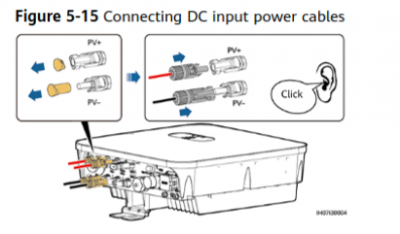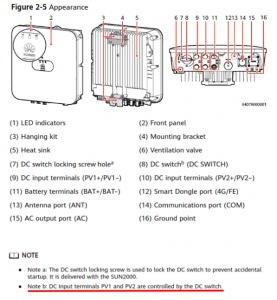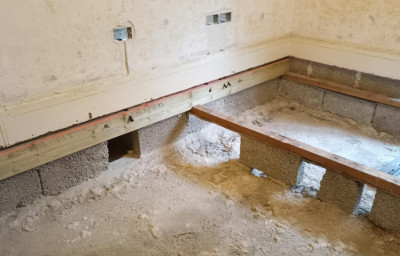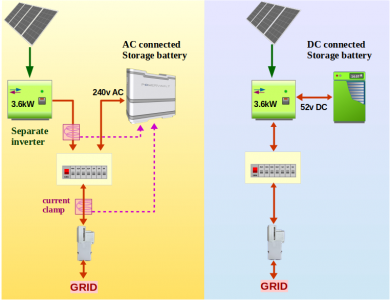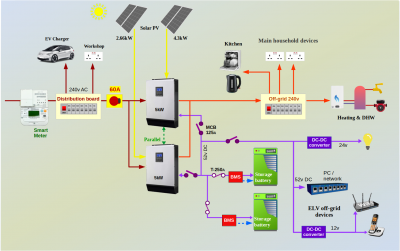@transparent Well they sound promising, SOC isnt crucial to me, but its nice to have. Im hoping to get a timber frame shell up early next year and there would be nothing stopping me from installing a new battery system then inside it. if the inverter isnt reusable then I could get the whole thing fully functional before switching the panels over. 🙂
Good luck with the floor 🙂 Im having a day off DIY!
House-2 bed partial stone bungalow, 5kW Samsung Gen 6 ASHP (Self install)
6.9 kWp of PV
5kWh DC coupled battery
Blog: https://thegreeningofrosecottage.weebly.com/
Heatpump Stats: http://heatpumpmonitor.org/system/view?id=60
@irmartini Ive looked into this further and I think that the minimum 5kWh solar production is in fact the battery charge as it is DC coupled and the sensor wont distinguish between that and solar production. This then explains why my back of a fag packet calculation differs so much from the later one using the Octopus data! Thanks for solving the mystery for me. 🙂
House-2 bed partial stone bungalow, 5kW Samsung Gen 6 ASHP (Self install)
6.9 kWp of PV
5kWh DC coupled battery
Blog: https://thegreeningofrosecottage.weebly.com/
Heatpump Stats: http://heatpumpmonitor.org/system/view?id=60
@bontwoody - I've read through several specifications and manuals for your Huawei inverter.
The installation instructions are in English, but it's not the finest piece of draughtsmanship I've seen.
The two pairs of solar panel inputs and the battery connections are all referred to as "DC power inputs"
They all use the same MC4 connectors, and are placed next to each other!!
Worse still, the adjacent DC-switch isolates the two solar inputs, but not the battery.
Your attention to this important safety feature is carefully tucked away as Footnote B, which I've underlined in red.
In a nutshell, the inverter is nothing special.
Huawei have concentrated their efforts on delivering a snazzy App, which is what you'd expect from a Smartphone company.
You can use non-Huawei batteries with different capacity.
It is generally frowned upon to mix batteries with very different overall capacity ratings.
Yes it will work, but the currents will be quite different and the BMS units are unlikely to provide any useful SoC data.
You can (optionally) buy a Peacefair Coulometer PZEM-015 unit and try it with your existing battery.
It would be an interesting cheap test to see if it's any different to the Huawei SoC calculations.
Save energy... recycle electrons!
@transparent Thanks for looking at all this, hope the floor went well. I neglected to mention that my battery is DC coupled, I hope that doesnt change anything.
I confess Im a bit nervous about disassembling the battery, where would the coulometer go? (I really want to put a 'b' in there)
House-2 bed partial stone bungalow, 5kW Samsung Gen 6 ASHP (Self install)
6.9 kWp of PV
5kWh DC coupled battery
Blog: https://thegreeningofrosecottage.weebly.com/
Heatpump Stats: http://heatpumpmonitor.org/system/view?id=60
@bontwoody Perhaps the bee ran out of charge 😉
Toodles, heats his home with cold draughts and cooks food with magnets.
Posted by: @bontwoodyI neglected to mention that my battery is DC coupled
That can be interpreted several ways, depending where that coupling goes.
Are you saying that your PV panels are connected to the battery, rather than the inverter?
... because that's not what it looks like in the photo you posted.
There should be a pair of wires going between the battery and the inverter.
They will have about 52v across them.
That's where a coulometer goes.
It's unnecessary to open the battery.
As for progress on my floor....
... it's still missing a few bits:
Apparently, the room requires joists, and a floor - or so my wife tells me.
I've explained that it's not that straightforward... and that I have indeed created a flaw.
Save energy... recycle electrons!
@transparent Im not clear of the actual connections, I just know that the DNO would allow the batteries connected like this and not AC coupled as usual. My feeling is that the battery sits between the panels and inverter although how the charging is managed I have no idea.
Re floor: emphasise the advantages of the increased headroom you have created 🙂
House-2 bed partial stone bungalow, 5kW Samsung Gen 6 ASHP (Self install)
6.9 kWp of PV
5kWh DC coupled battery
Blog: https://thegreeningofrosecottage.weebly.com/
Heatpump Stats: http://heatpumpmonitor.org/system/view?id=60
It sounds like your installer was the one who actually communicated with your DNO,
and has then given you a partial explanation.
On the left is an AC-coupled battery, next to a solar inverter.
That battery unit from PowerVault has its own integral inverter.
If both the green inverter and the battery were to export to the grid, then the combined current could exceed 16A (3.68kW),
and the DNO would need to grant G99 approval.
Approval would most likely be granted with the condition that export current was limited to 16A by the use of an approved current-measuring system.
Your Huawei battery has no possible AC output,
nor can it accept direct connection of solar panels.
It's DC coupled to the inverter.
Output to the grid is limited purely by the inverter only being able to output 16A at 240v.
And it's that last factor which might cause you to consider selling on both your Huawei battery and the inverter.
An inverter which can only output 3.68kW is short of what you might require for the house.
One major advantage of having a sub-floor void is that it's a good environment in which to place a further 500kWh of storage battery 🙂
Save energy... recycle electrons!
@transparent OK, thats clear. I didnt pay a lot of attention to the details but I knew it was to prevent export from both the panels and the battery at the same time.
Something perhaps I should have mentioned is that I have a separate 2.66 kV PV array which came with the house and has a good FIT payment. It has its own Fronius inverter. The two systems are totally separate as you would expect.
The solar array connected to the battery system is about 4.3 kV.
You could perhaps get enough batteries under there to have an electric house vehicle 🙂
House-2 bed partial stone bungalow, 5kW Samsung Gen 6 ASHP (Self install)
6.9 kWp of PV
5kWh DC coupled battery
Blog: https://thegreeningofrosecottage.weebly.com/
Heatpump Stats: http://heatpumpmonitor.org/system/view?id=60
There are no post-installation checks on installations which have already been accepted for FIT payments.
For example, if your Fronius inverter were to fail, then you'd be able to replace it with a different/newer unit without needing to have your site re-approved.
There's nothing to prevent you re-directing that original 2.66kW PV array to supply an inverter which connects with a storage battery.
It still fulfills the overall aim of the FIT scheme, in that it:
- reduces demand on the grid during peak periods
- reduces losses due to phase-imbalance at the local substation
So you could consider the following arrangement for example:
In effect the house runs off storage batteries most of the time.
You can have as many inverters as required to supply the load presented by the house.
You can have as many storage batteries as you wish, to increase the amount of time between charging.
With enough storage, you can avoid recharging from the grid until the next sunny day arrives.
Having more than one inverter and battery provides greater resilience against a fault.
This isn't a direct proposal for your home.
I'm merely putting this forward to let you have a vision of what's possible.
Finally, you will note that I've adjusted your specification of the solar panels operating at 2.66 and 4.3 kilovolts respectively.
Such a high voltage would likely exceed the specification for the insulation on wires and connectors!
Shall we stick to kilowatts (kW) in future? 😉
Save energy... recycle electrons!
LOL kV...Sorry Im reverting back to radiography mode! I do know the difference ...honest 🙂
No one has ever suggested that possibility to me and the idea of charging the battery from both solar arrays is attractive. Had the installer suggested it, I might well have found some additional funds at the time.
Im not really worried about having DC feeds or an off grid capability really (unless it was stupidly cheap to add on).
Im guessing the inverters would have to be the same power as currently fitted to keep the DNO happy?
Thanks for this.
House-2 bed partial stone bungalow, 5kW Samsung Gen 6 ASHP (Self install)
6.9 kWp of PV
5kWh DC coupled battery
Blog: https://thegreeningofrosecottage.weebly.com/
Heatpump Stats: http://heatpumpmonitor.org/system/view?id=60
@transparent So doing a bit of further research, Ive come up with these options:
1. Add extra module to Huawei system, cost £2200, result 10 kWh
2. Build battery in Seplos enclosure, cost £2000 - resale of luna module, result 14 kWh
3. Buy Fogstar battery, cost £2500 - resale of luna module, result 15.5.kWh
options 2&3 may require me to change the Huawei inverter too.
Are all three options capable of having the second solar array wired into the battery with another inverter?
Cheers Mark
House-2 bed partial stone bungalow, 5kW Samsung Gen 6 ASHP (Self install)
6.9 kWp of PV
5kWh DC coupled battery
Blog: https://thegreeningofrosecottage.weebly.com/
Heatpump Stats: http://heatpumpmonitor.org/system/view?id=60
- 26 Forums
- 2,342 Topics
- 53 K Posts
- 259 Online
- 6,000 Members
Join Us!
Worth Watching
Latest Posts
-

RE: Free Ecoheat Heat Pump Install
@deltona happy to help as much as I can if you decide t...
By bontwoody , 1 minute ago
-

RE: Are We Sleepwalking Into Another Race to the Bottom?
I'll be honest, I love that idea! I'll start working on...
By Mars , 20 minutes ago
-
-
RE: Configuring third party dongle for Ecodan local control
@majordennisbloodnok I think the HPDHD diagnosis may be...
By Sheriff Fatman , 2 hours ago
-

RE: External pipework insulation
I don't think we can tell from a photo whether your exi...
By Transparent , 2 hours ago
-
RE: Controlling Daikin Altherma via P1P2 and Home Assistant
@majordennisbloodnok That’s correct. I can’t find anywh...
By weoleyric , 8 hours ago
-
RE: Octopus Cosy Heat Pump Owners & Discussion Thread
@andrewj yeah we recreated it. Engineer seemed to think...
By swwils , 9 hours ago
-

RE: Setback savings - fact or fiction?
@robs — thanks again for your detailed comments. Some r...
By cathodeRay , 1 day ago
-

RE: A Smarter Smart Controller from Homely?
@papahuhu I hope you get a swift resolution. Regards, T...
By Toodles , 1 day ago
-

RE: Poll for Time of Use, tariffs, technology
That’s fine by me too Major, I feel it is a sad reflect...
By Toodles , 1 day ago
-

Bingo. Sometimes a judiciously placed size 10 bovver bo...
By Majordennisbloodnok , 1 day ago
-
RE: Mitsubishi Ecodan 11.2kW heat pump with low COP
@ciocoiu-alexandru I can't provide the same level of di...
By Sheriff Fatman , 1 day ago
-

The three technical issues I'm considering are: BMS...
By Transparent , 1 day ago
-
RE: LiFePO4 lithium battery fires and explosions
@transparent Your post may fit better in th...
By Batpred , 1 day ago
-

RE: British Gas vs Octopus Energy vs Heat Geek vs EDF vs Aira vs OVO vs EON.Next vs Boxt
@jamespawhite, if you could be bothered, you could also...
By Mars , 1 day ago
-
RE: Commencing on an ASHP Installation Process
I've got a bit of time to draft something today, so the...
By Sheriff Fatman , 2 days ago
-
RE: Help with heat pump sizing
@amin I dont think materially relative to t...
By JamesPa , 2 days ago
-

@majordennisbloodnok I have decided to take the plunge....
By TechnoGeek , 2 days ago

